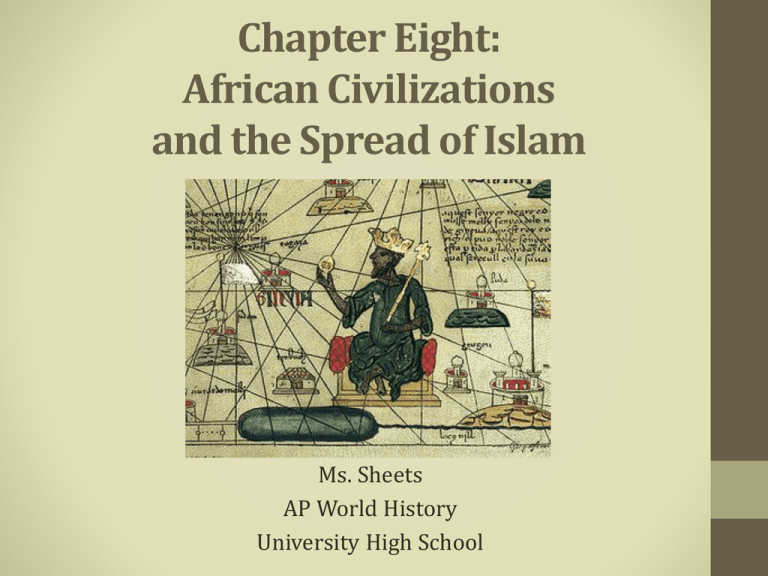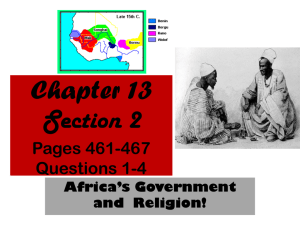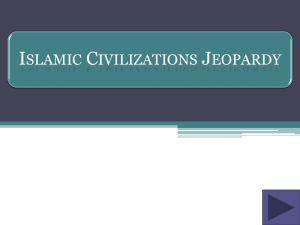Spread of Islam to Africa
advertisement

Chapter Eight: African Civilizations and the Spread of Islam Ms. Sheets AP World History University High School African Regions Pre-Islamic Africa • Extremely diverse societies developed • Political unity was difficult because of terrain • Bantu is primary language spoken • Oral traditions; very few written records • Most communities are preliterate (lacking writing system) • Animistic and polytheistic religions common • Majority of Africa, even after introduction of Islam, will remain in isolation • Many who are exposed to Islam do not convert but remain practitioners of their indigenous religion “Stateless” Societies • Many small communities are politically organized in this way • Authoritarian and centralized empires will exist, however. • Lack concentration of power and authority • Authority and power normally exercised by a ruler and court is held by a council or families or community • Weakness of stateless societies • No organization to collect taxes no effective militaries • No consensus Difficult to resist external pressures • No undertaking of large building projects • Hard to create stability for long-distance trade • Internal problems could be resolved by allowing dissidents to leave and establish new villages African Economy • Economies vary by region • N. Africa integrated into the world economy via Islamic trade routes and Mediterranean • Most participate in agriculture and ironworking • Africans exchanged abundant raw materials for manufactured goods. Influence of Islam in Africa • 7th century: Muslim armies moved west from Egypt across N. Africa • Spreads Islamic influence; rapid conversions • Traders and travelers brought Islam along pre-existing caravan routes. • Berbers (people of the Sahara) begin to convert to Islam • 11th-12th centuries: Almoravids and Almohads (reforming Muslim Berbers) from western Sahara grow in power • • • • Launch jihad (war to spread and protect faith) Almohads defeat Almoravids Almohad Caliphate: 1121-1269 These groups are essential to penetration of Islam throughout Africa. Almoravids 1040-1147 Grasslands Kingdoms • Sahel Grasslands: transition zone between Sahara Desert and savannahs to the south • Point of exchange between North and Sub-Saharan Africa; important region of trade • Grasslands Kingdoms = Sudanic States = Ghana, Mali, Songhai Sudanic States • Islam reinforced ideas of kingship and power: “royal cult” • Joining Islam gives rulers prestige and associates them with other great Muslim leaders • Majority of population never converted but retain their polytheism/animism • Trade gold for salt from Berbers in North Africa • Mali, Ghana and Songhai • Combine Islamic religion/culture with local practices • Each incorporates the previous kingdom; bigger than last Ghana 4th – 11th c. • 1st great West African empire • Rose to power by taxing salt and gold • 10th c: rulers convert to Islam while common people remain loyal to polytheism • Reaches 11th c. height • Almoravid armies invaded Ghana in 1076 Mali • Broke away from Ghana in 13th c. • Economy: agriculture and gold trade • Traders spread beyond W Africa • Very wealthy empire • Islamized state in 13th c. when rulers convert • Founder: Sundiata (dies 1260) • Credited with Malinke expansion and creation of unified state with each tribe having a representative at court • Mansa Musa is successor • Jenne and Timbuktu • Major cities of commercial exchange • Scholars, craft specialists, and foreign merchants • Timbuktu was famous for its library and university Mansa Musa • 1324: Hajj to Mecca • Aligns himself with elite Islamic rulers • Brings back scholars, architects • Inadvertently devastates economies he enters • Indicates wealthy, sophisticated empires existed in Africa • Estimated wealth: $400 billion Songhai • Independent from Mali in 1370s • Prospered as a trading state and military power. • Founded by Sunni Ali (1464-1492) • Great military leader; extended rule over the entire Niger River valley. • Songhai remained dominant until defeated by Moroccans in 1591 for not being “Muslim enough” Influence of Islam in Grasslands Kingdoms • Islam provided universal faith and fixed law. • Rulers reinforced authority through Muslim ideology. • Many Sudanic societies were matrilineal and did not seclude women. • Hesitancy over conversion to Islam since it restricts women more than these societies did • Slavery and slave trade was prevalent from Muslim influence Swahili Coast of East Africa • Coasts enable East Africa to be connected to India Ocean trade • Islamized trading ports along coast by 13th c. • Kilwa, Mogadishu, Mombasa: large city-state centers of Islam • Ibn Battuta: Islamic scholar/writer who visits these cities • Exported raw materials in return for Indian, Islamic and Chinese luxuries • Swahili language (Bantu + Arabic) emerged in urbanized trading ports • Rulers and merchants were often Muslim. • Most of the population retained African beliefs and few converted to Islam • Culture = Swahili as language and fused African and Islamic practices. Central Africa • Across central Africa, agrarian societies thrived and kingdoms developed • Yoruba • Non Bantu-speaking • Highly urbanized agriculturalists • Benin • Forms in 14th century under ruler/oba Ewuare the Great • Ruled from the Niger River to the coast near Lagos • Luba • Divine kingship • Hereditary bureaucracy Central Africa without Islam • Both develop free of Islamic contact • Kongo • Agricultural society, flourishes by 15th • Gender division of labor and family-based villages • Largest site: Mbanza Kongo = 60,000-100,000 people • Zimbabwe • Great Zimbabwe, largest site • Dominated gold sources and trade with coastal ports Christianity in Africa • Christian states are present in North Africa, Egypt, and Ethiopia before the arrival of Islam. • Egyptian Christians, the Copts, had a rich and independent tradition (Coptic Christianity). • The Nubians resisted Muslim incursions from 9th until 13th century. • Ethiopia continues to retain Christianity. • Christianity will come later to the rest of the continent with the presence of Europeans. Global Connections • Spread of Islam brought large areas of Africa into the global community through increasing contact from 700-1500 CE between Africa and Mediterranean and Asian civilizations. • Sudanic states and East Africa • However, most of Africa evolved in regions free of Islamic contact (Central + Southern Africa). • Organized their lives in stateless societies. • While no universal empires and religions develop in Africa, Christianity and Islam impact the region through political, economic, and cultural development.






